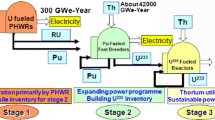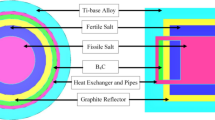Abstract
Molten salt reactors (MSR) are Generation-IV fission reactors. MSR is a class of nuclear fission reactors in which the coolant is a mixture of molten salts. They are very compact design of nuclear reactors. Many agencies working on this conclude that MSR can deliver a safe, economical, sustainable energy, without generation of CO2 gas. As MSRs operate at very high temperatures compared to water cooled reactors, they have high thermodynamic efficiency. The molten salts are more efficient than compressed helium as it can remove more heat from core, hence making the system more compact. However, many constraints have been identified which could create setbacks in MSR. Many of these have been addressed to a large extent by various research works that were carried out throughout the world. This paper reviews the evolution of molten salts as coolant and since the Indian nuclear program has identified FLiNaK as one of the candidate coolants for the Indian MSR, a review on the degradation of structural materials in FLiNaK medium is also presented and discussed.
Access this chapter
Tax calculation will be finalised at checkout
Purchases are for personal use only
Similar content being viewed by others
References
Ho MKM, Yeoh GH, Braoudakis G (2003) Molten Salt reactors. In: Méndez-Vilas A (ed) Materials and processes for energy: communicating current research and technological developments, 1st edn. Formatex Research Center Publication
Sona CS, Gajbhiye BD, Hule PV, Patwardhan AW, Mathpati CS, Borgohain A, Maheshwari NK (2014) High Temperature corrosion studies in molten salt-FLiNaK. Corros Eng Sci Technol 49–4:287–295
Mathieu L, Heuer D, Brissot R, Garzenne C, Le Brun C, Lecarpentier D, Liatard E, Loiseaux J-M, Méplan O, Merle-Lucotte E, Nuttin A, Walle E, Wilson J (2006) The thorium molten salt reactor: moving on from the MSBR. Prog Nucl Energy 48:664–679
Williams DF (2006) Assessment of candidate molten salt coolants for the NGNP/NHI heat transfer loop. Oak Ridge National Laboratory report no ORNL-TM-2006/69
Alexander LG, Carrison DA, Mac Pherson HG, Roberts JT (1959) Nuclear characteristics of spherical homogeneous two region molten fluoride salt reactor. Oak Ridge National Laboratory report no ORNL-2751, TID-4500 (14th edn)
Williams DF, Toth LM, Klarno KT (2006) Assessment of candidate molten salt coolants for the Advanced High-Temeprature Reactors (AHTR). Oak Ridge National Laboratory report no ORNL/TM-2006/12
Vijayan PK, Basak A IV, Dulera KKV, Basu S, Sinha RK (2015) Conceptual design of Indian molten salt breeder reactor. Pramana-J Phys 85(3):539–554
Janz GJ, Dampier FW, Lakshminarayanan GR, Lorenz PK, Tomkins RPT (1968) Molten salt: Volume-1, electrical conductance, density and viscocity data. National Standard Reference Data series, National Bureau of Standards
Cantor S (1968) Physical properties of molten salt reactor fuel coolant and flush salts. Oak Ridge National Laboratory report no ORNL-TM-2316
Benes O, Konings RJM (2009) Thermodynamic properties and phase diagrams of fluoride salts for nuclear applications. J Fluor Chem 130:22–29
Misra AK (1988) Fluoride salts as phase change materials for thermal energy storage in the temperature range 1000–1400 K. J Electrochem Sci Technol 135–4:850–854
Endicott N (2013) Thorium-fuelled molten salt reactors. Report by Weinberg Foundation, London
Rosenthal MW, Kasten PR, Briggs RB (1970) Molten salt reactor-history, status and potential. Nucl Appl Technol 8–2:107–117. https://doi.org/10.13182/NT70-A28619
Wang Y, Liu H, Zeng C (2014) Galvanic corrosion of pure metals in molten fluorides. J Fluor Chem 165:1–6
Manly WD, Adamson Jr GM, Cooba JH, DeVon JH, Douglas DA, Hoffman EE, Patriarca P (1957) Aircraft Reactor experiment—metallurgical aspects. Oak Ridge National Laboratory report no ORNL-2349
Misra AK, Daniel Whittenberger J (1987) Fluoride salts and container materials for thermal energy storage application in temperature range 973 to 1400K, NASA Technical memorandum 89913 AIAA-87–9226. In: 22nd intersociety energy conversion engineering conference, Philadelphia, Pennsylvania, August 10–14, 1987
Metzger G (1968) Survey of structural materials for molten salt experiment (MOSAL) reactor. Nucl Eng Des 7:29–39
Macpherson HG (ed) (1958) Construction materials for molten salt reactors. In: Fluid fuel reactors Part-II—molten-salt reactors. Oak Ridge National Laboratory, Addison-Wesley Publishing Company
De Van JH, Evans RB (1962) Corrosion behavior of reactor materials in fluoride salt mixtures. Oak Ridge National Laboratory report no ORNL-TM-328
Savage HC, Compere EL, Baker JM, Bohlmann EG (1967) Operation of molten-salt convection loops in the ORR. Oak Ridge National Laboratory report no ORNL-TM-1960
McCoy HE, Beatty RL, Cook WH, Gehlbach RE, Kennedy CR, Koger JW, Litman AP, Sessions CE (1970) New developments in materials for molten salt reactors, ORNL. Nucl Appl Technol 8:156–169
Ouyang FY, Wang YS, Wang MY, You BC, Yeh TK, Kai JJ (2014) Influence of purification process on incipient material corrosion in molten FLiNaK salts. Corros Eng Sci Technol 49–2:101–108. https://doi.org/10.1179/147842213X13826021335978
McCoy Jr HE (1978) Status of material development for molten salt reactors. Oak Ridge National Laboratory report no ORNL/TM-5920
Sawant SS, Gajbhiye BD, Tyagi S, Sona CS, Divya R, Mathpati CS, Borgohain A, Maheshwari NK (2016) High temperature corrosion studies in molten salt using salt purification and alloy coating. Indian Chem Eng. https://doi.org/10.1080/00194506.2016.1256236
Olson LC, Ambrosek JW, Sridharan K, Anderson MH, Allen TR (2009) Material corrosion in molten LiF-NaF-KF salt. J Fluor Chem 130:67–73
Olson L, Sridharan K, Anderson M, Allen T (2010) Intergranular corrosion of high temperature alloys in molten fluid salts. Mater High Temp 27–2:145–149
Kondoa M, Nagasakaa T, Tsisar V, Sagaraa A, Murogaa T, Watanabe T, Oshima T, Yokoyama Y, Miyamoto H, Nakamura E, Fujii N (2010) Corrosion of reduced activation ferritic martensitic steel JLF-1 in purified FLiNaK at static and flowing conditions. Fusion Eng Des 85:1430–1436
Liu M, Zheng J, Lu Y, Li Z, Zou Y, Yu X, Zhou X (2013) Investigation of corrosion behaviour of Ni-based alloys in molten fluoride salt using synchrotron radiation technicques. J Nucl Mater 440:124–128
Ouyang F-Y, Chang C-H, Kai J-J (2014) Long term corrosion behaviors of Hastelloy-N and Hastelloy-B3 in moisture containing molten FLiNaK salt environments. J Nucl Mater 446:81–89
Ouyang F-Y, Chang CH, You B-C, Yeh T-K, Kai J-J (2013) Effect of moisture on corrosion of Ni-based alloys in molten alkali fluoride FLiNaK salt environment. J Nucl Mater 437:201–207
Zhu Y, Hou J, Yu G, Qiu J, Chen S, Zhou X (2016) Effects of exposing temperature on corrosion performance of weld joint of a Ni-Mo-Cr alloy. J Fluor Chem 182:69–75
Keiser JR, De Van JN, Lawrence EJ (1979) Compatibility of molten salt with type 316 SS and Lithium. J Nucl Mater 85 & 86:295–298
Maric M, Muransky O, Karatchevtseva I, Ungar T, Hester J, Studer A, Scales N, Ribarik G, Primig S, Hill MR (2018) The effect of cold-rolling on the microstructure and corrosion behaviour of 316L alloy in FLiNaK molten salt. Corros Sci 142:133–144
Guopiang ZONG, Bo CHEN, Long ZHANG, Jiahong SUN, Qun’an DONG, Wei CHEN, Jichang XIAO (2014) Preparation of FLiNaK molten Salt. Nuclear Techn 37–5:6
Wang C, Chen W, Chen M, Chen D, Yang K (2019) Corrosion behaviour and elements interdiffusion between a Ni coating and GH3535 alloy with and without a CrN barrier in molten fluoride salts. J Nucl Mater 514:348–357
Zong G, Zhang Z-B, Sun J-H, Xiao J-C (2017) Prepartion of high-purity molten FLiNaK salt by the hydro-fluorination process. J Fluor Chem 197:134–141
Author information
Authors and Affiliations
Corresponding author
Editor information
Editors and Affiliations
Rights and permissions
Copyright information
© 2022 The Author(s), under exclusive license to Springer Nature Singapore Pte Ltd.
About this chapter
Cite this chapter
Harinath, Y.V., Mohan, T.V.K., Rangarajan, S., Albert, S.K. (2022). Structural Materials for Molten Salt Reactors. In: Kamachi Mudali, U., Subba Rao, T., Ningshen, S., G. Pillai, R., P. George, R., Sridhar, T.M. (eds) A Treatise on Corrosion Science, Engineering and Technology. Indian Institute of Metals Series. Springer, Singapore. https://doi.org/10.1007/978-981-16-9302-1_10
Download citation
DOI: https://doi.org/10.1007/978-981-16-9302-1_10
Published:
Publisher Name: Springer, Singapore
Print ISBN: 978-981-16-9301-4
Online ISBN: 978-981-16-9302-1
eBook Packages: Chemistry and Materials ScienceChemistry and Material Science (R0)




